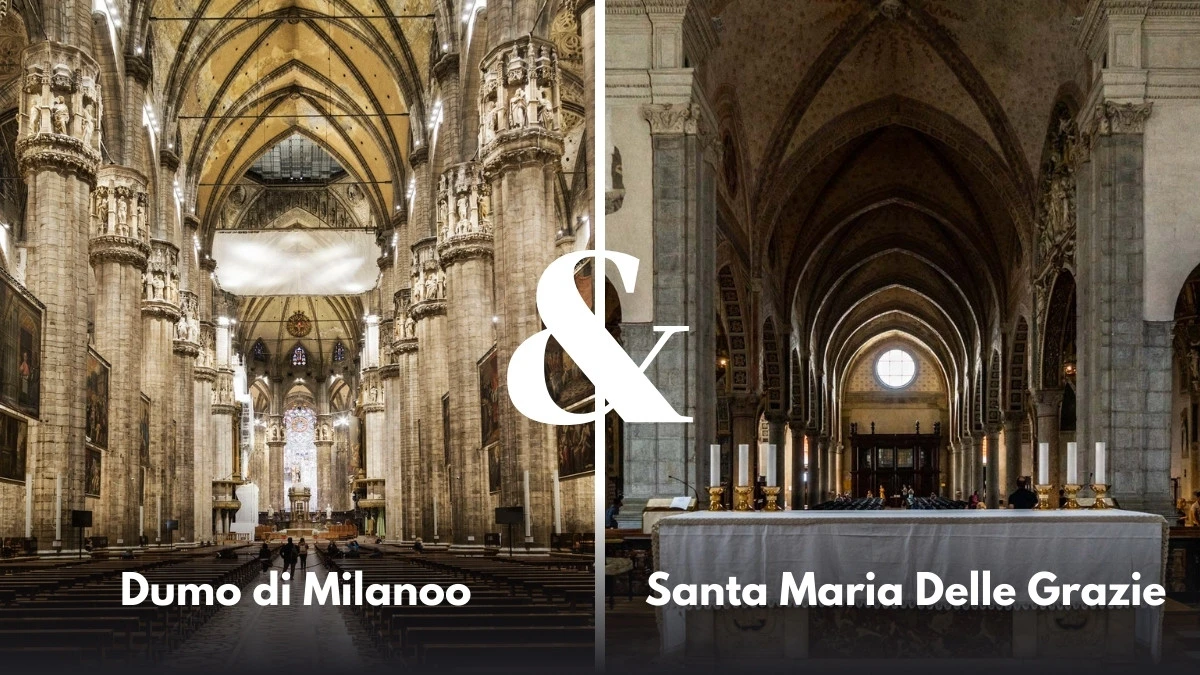Milan, a city renowned for its artistic and cultural treasures, boasts two iconic landmarks that stand as testaments to its rich heritage: the majestic Duomo di Milano and the historic Santa Maria delle Grazie.
While distinct in their architectural styles and purposes, these sites are intertwined by their shared history, artistic significance, and enduring allure, offering visitors a captivating glimpse into Milan’s vibrant past and artistic legacy.
Duomo di Milano: A Gothic marvel
The Duomo di Milano, a breathtaking Gothic cathedral, has graced the city’s skyline since the 14th century.
Its intricate facade, adorned with 135 spires and 3,400 statues, exemplifies the grandeur of high Gothic architecture, captivating visitors with its sheer scale and artistic detail.
Key highlights of the church
Architectural fusion: While predominantly Gothic, the Duomo’s design incorporates elements from various architectural schools, showcasing a unique blend of French Gothic and Renaissance influences.
Monumental scale: As Italy’s largest church and the third largest in the world, the Duomo can accommodate up to 40,000 people, a testament to its impressive engineering and design.
Symbolism and artistry: From the sundial at its entrance to the statue of Saint Bartholomew at the altar, the Duomo is replete with symbolic elements and artistic masterpieces. The 55 stained glass windows depicting biblical tales and the 26 rooms of the Cathedral Museum narrating 600 years of history through art, tapestries, and treasures enrich the visitor experience.
Panoramic views: The Duomo’s terraces, the largest walkable rooftop on any Gothic cathedral, offer unparalleled vistas of Milan and the distant Alps.
Must Reads: What to see inside Santa Maria delle Grazie and why it is better than Duomo Di Milano.
Santa Maria delle Grazie: Home to The Last Supper

Santa Maria delle Grazie, a historic church and Dominican convent, holds a special place in art history as the home of Leonardo da Vinci’s masterpiece, The Last Supper.
While less imposing in scale than the Duomo, this UNESCO World Heritage site exudes a quiet grandeur, drawing visitors to experience the artistic brilliance of da Vinci’s iconic mural.
Why is Santa Maria delle Grazie special?
Renaissance influence: Commissioned by the Duke of Milan, Francesco I Sforza, in the 15th century, the complex reflects the artistic flourishing of the Renaissance period. Architect Guiniforte Solari initially designed the church in the Gothic style, but later expansions by Donato Bramante incorporated Renaissance features, creating a harmonious blend of architectural styles.
Artistic treasures: While The Last Supper is undoubtedly the star attraction, the complex houses other artistic gems. These include Donato Montorfano’s The Crucifixion, located in the refectory alongside da Vinci’s masterpiece, and frescoes by renowned artists like Gaudenzio Ferrari in the church’s chapels.
The refectory and The Last Supper: The refectory, a separate building adjacent to the church, houses da Vinci’s The Last Supper on its north wall. This space, once a dining hall for the monastic community, now serves as the Last Supper Museum (Cenacolo Vinciano), allowing visitors to experience the artwork in its intended setting. You need Last Supper tickets to enter the refectory.
A serene cloister: The cloister, also known as the Chiostro delle rane (The cloister of the frogs), provides a tranquil escape within the complex. Its central garden, round basin, and cobbled paths offer a peaceful retreat for contemplation and reflection.
RECOMMENDED
Opening hours of Santa Maria delle Grazie
How to reach Santa Maria delle Grazie
Facts about Last Supper church in Milan
Connecting the masterpieces: A shared history
The Duomo and Santa Maria delle Grazie are just 1.8 kilometers (1.1 miles) from each other. While architecturally distinct, they are connected by a shared history and artistic legacy that reflects Milan’s evolution as a cultural hub.
Patronage of the Sforza family: Both sites benefited from the patronage of the powerful Sforza family, who played a crucial role in shaping Milan’s artistic landscape during the Renaissance period. Their commissions and support fostered the creation of these masterpieces, leaving an indelible mark on the city’s artistic heritage. Note: The Sforza family also built the Sforza Castle.
Renaissance influences: The Duomo, while primarily Gothic, exhibits Renaissance influences in some of its later additions. Santa Maria delle Grazie, on the other hand, showcases a more pronounced Renaissance style, particularly in the additions made by Donato Bramante. This shared influence reflects the broader artistic trends sweeping Italy during this period.
Enduring legacy: Today, the Duomo and Santa Maria delle Grazie symbolize Milan’s artistic and cultural prowess, attracting millions of visitors annually. They serve as reminders of the city’s rich history and enduring legacy as a center of creativity and innovation.
Visiting both sites: Tips for a memorable trip
A trip to Milan would be incomplete without experiencing both the Duomo and Santa Maria delle Grazie. Here are some tips to enhance your visit:
Plan ahead: Due to their popularity, it’s crucial to plan your visit in advance, especially for Santa Maria delle Grazie. Tickets for The Last Supper often sell out weeks or even months ahead, so booking online is highly recommended. Buy tickets
Transportation options: Both sites are easily accessible by public transportation. The metro, tram, and bus systems offer convenient connections throughout the city.
Combine with other attractions: Consider combining your visits with nearby attractions, such as the Galleria Vittorio Emanuele II, Sforza Castle, or the Pinacoteca di Brera.
By immersing yourselves in the grandeur of the Duomo and the artistic brilliance of Santa Maria delle Grazie, you’ll gain a deeper appreciation for Milan’s enduring cultural legacy and the captivating stories that these iconic landmarks have to tell.
If you plan to visit only Last Supper church, check out our tips for visiting Santa Maria delle Grazie.

